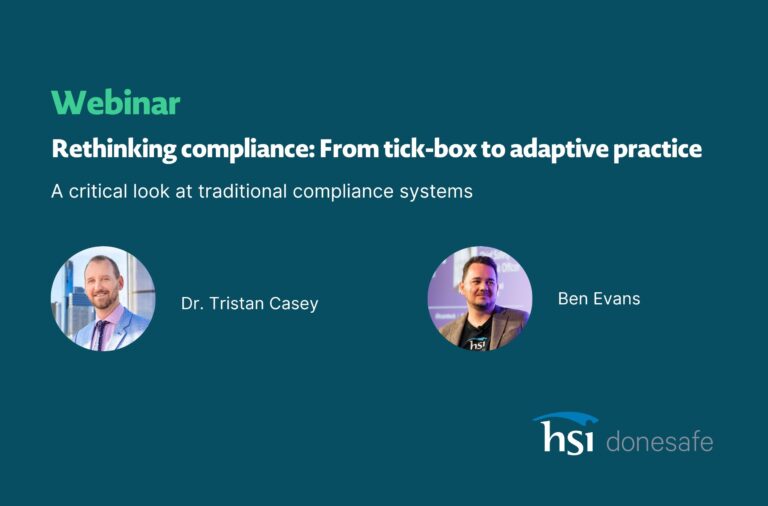
At what cost, are you putting your company at risk?
When it comes to dealing with non-compliance in Environmental, Health, and Safety (EHS) management, one of the first things on most people’s minds are the financial damages. Of course, the prospect of losing money serves as a good deterrent for non-compliance. However, pursuing EHS compliance mainly for the sake of avoiding financial penalties can also underestimate other, potentially more damaging, risks associated with EHS non-compliance. Taking into account the sum of these risks, financials and beyond provides a more holistic and comprehensive approach to EHS management and compliance. Overall, the costs of non-compliance greatly outweigh the costs of compliance.
It might sound counterintuitive, but when comparing the impact of different penalties for EHS non-compliance, the financial repercussions may end up causing the least amount of long-term headaches. This doesn’t intend to discount the tremendous losses that these penalties can incur, especially if the company does not have the funds to sustain the financial setback. However, there are worse consequences than even a financial hit, because, in the end, numbers and figures can be accounted for and calculated by nature. The intention of financial penalties is to create differences in behavior that encourage compliance, so their impact cannot be ignored. However, the fact that they can be calculated makes it easier to project the impact of the loss on the bottom line and to eventually move forward from there.
What are the indirect implications?
On the other hand, indirect costs may linger much longer and do more lasting damage than financial penalties. These repercussions can be more or less tangible. For instance, a permanent loss or fluctuation in stock price is more tangible than a loss of brand credibility or damage to a company’s reputation. However, both of these can be much more difficult to account for and to bounce back from than a one-time financial penalty, no matter the sum. If the incident of non-compliance is significant enough to be a matter of public interest, the residual impacts of public and media scrutiny can attract attention long after the fines have been paid off. These indirect costs than end up transforming into tangible, material costs, in the form of lost revenue.
It may not be immediately apparent that the costs of non-compliance are actually increasing, but there are many indicators that this is happening. In the United States, financial penalties have remained rather high, despite a more recent trend toward reducing regulations. One sign of the heightened scrutiny of private industries’ commitment to EHS compliance is the increase in the dollar amount of fines levied against violators. The largest of these fines in 2018 thus far surpassed $1 million.
OSHA’s changes in 2018
Aside from governmental oversight, there is an increasing expectation from a variety of stakeholders that a company’s conduct should reflect a commitment to high standards of ethics and compliance. In January 2018, the U.S. Occupational Safety & Health Administration (OSHA) significantly increased its fines, with a maximum limit of $12,934 for “serious” and “non-serious” violations and a cap of $129,336 for “willful” and “repeat” violations. OSHA compliance enforcement is certainly following the trend towards increased awareness and vigilance of EHS compliance, including the implementation of harsher fines.
Being compliant is also never just a matter of following a single policy. Confusion can occur due to overlapping jurisdictions and boundaries between different regulatory agencies. In the US, the case of OSHA and the Environmental Protection Agency (EPA) provides a good case study. According to EHS Today, these two agencies both have jurisdiction and individual policies about exposure to toxic substances in the workplace. Their takeaway is that OSHA compliance alone is not enough to safeguard against violations and that companies should be more aware of how each agency’s regulatory reach and jurisdictional authority affect them.
What are the hidden costs involved in EHS non-compliance?
Other than regulatory fines, additional financial burdens include a variety of administrative costs, such as workers’ compensation payouts and lawyers’ fees. Projecting these costs ahead of time may prove to be problematic because it can be difficult to estimate how long the company might continue to be liable for these costs.
Among the costs that are even more challenging to calculate are the intangible and unpredictable ones: damage to brand, reputation, and image. These costs can vary depending on how well-known the company is and the amount of public and media attention the violation attracts.
Usually, these intangible costs are compounded by the severity of the violation and its impact on individuals and the environment. The Deepwater Horizon oil spill, commonly known as the BP oil spill, was the largest oil spill in U.S. history, causing known and still unknown harm to coastal ecosystems. Although the incident occurred in 2010, BP is still facing lawsuits and paying claims related to the immediate and residual impacts of the spill. As of January 2018, the total settlement paid out amounted to a whopping $65 billion, and BP’s stock price has never fully rebounded.
However, you do not have to be a massive multinational company with a large potential to cause environmental havoc in order to feel the costs of EHS non-compliance. In fact, the smaller the company, the stronger the impact of financial penalties that might represent just a drop in the bucket for a large multinational. Financial penalties are intimidating enough, but they aren’t always even the largest share of the total cost of non-compliance. In fact, business disruption, productivity loss, and revenue loss were individually found to be more costly than the sum total of all regulatory fines.
Let’s compare the cost of compliance vs. non-compliance
It goes without saying that compliance certainly has its costs as well. A report by the Ponemon Institute found that the cost of compliance for a group of 46 organizations studied amounted to more than $3.5 million. However, the report further elaborated that the cost of non-compliance was nearly triple that amount, at $9.4 million.
The investment of best practice EHS safety management will avoid unnecessary costs
Having a good safety record also means investing in the future of your organization. Potential employees will hesitate to work for an employer with a history of safety violations, limiting your ability to recruit and retain top talent. News about poor safety practices spreads quickly within an organization, impacting productivity at the moment by lowering morale and employee job satisfaction.
Successful and sustainable EHS management requires a suite of practices to help manage compliance and avoid both direct and indirect impacts. Clearly, every business has a financial incentive to comply with EHS regulations, as the costs of non-compliance can add up quickly. Wise and proactive budgeting is the best accessory to a strong EHS management protocol. With the costs of non-compliance steadily climbing, adding a budget line item for an EHS management system means allocating funds for prevention rather than mitigation.
An EHS management system is certainly a savvier way to allocate money, directing funds towards investment rather than a loss. And unlike financial penalties, investing in an EHS management system is a planned and forecasted expense.
True compliance requires adherence to both external, regulatory rules, as well as internal EHS company policies. Investing in a comprehensive EHS management plan is the surest strategy for balancing and fulfilling these twin obligations while minimizing risk and ensuring accurate accounting.
Related Articles –
The benefits of an EHS Management System
The Burning Question: How to Successfully Deploy an Online EHS Software System
And as always, keep safe out there.
By Donesafe at donesafe.com
Share:



